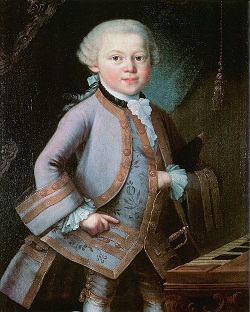How are you?
This week's lecture is “Wolfgang
Amadeus Mozart”, the 7th topic of “Classical
Music”, which is a summary of the contents of “92. Classical Music: 7. Wolfgang Amadeus Mozart” introduced on June 14th, 2017.
Wolfgang Amadeus Mozart
was a composer of the Classical era who was born on January 27, 1756 and died
on December 5, 1791.
 |
| Mozart's birthplace, Salzburg |
 |
| Portrait of the child Mozart |
Born in Salzburg, Mozart showed outstanding musical talent from an early age. He started composing at the age of five and performed in front of European royalty as he embarked on a grand tour.
 |
| The Mozart family on a grand tour |
At the age of 17, he worked as a musician at the Salzburg court, but he traveled to find a better position. Dismissed from Salzburg position during a visit to Vienna in 1781, Mozart decided to stay in Vienna, where he composed his most famous symphonies, concertos, operas and parts of the Requiem that was mostly unfinished at his death.
 |
| The first page of Mozart's autograph score in the Requiem |
After Mozart's death,
his wife, Constanze, entrusted the unfinished Requiem to his pupils to complete
the work, and finally Franz Xaver Süssmayr completed the work.
 |
| Constanze Mozart, Hans Hansen |
 |
| Franz Xaver Süssmayr |
Although Mozart died at a young age, he composed more than 600 works in almost every genre due to his rapid pace of composition, and many of which are recognized as the best works in the genres of symphonies, concertos, chamber music, opera and choral music.
He is regarded as one of the greatest classical composers of all time, and his
influence on Western music is immense. Ludwig van Beethoven composed his early
works in the shadow of Mozart, and Joseph Haydn wrote: "posterity will not
see such a talent again in 100 years".
 |
| Mozart Monument, Vienna |
As the cause of his
death is largely uncertain, it has been much mythologized, and researchers have
suggested more than a hundred causes of death, including acute rheumatic fever,
streptococcal infection, trichinosis, influenza, mercury poisoning, and a rare
kidney ailment.
Mozart's most famous pupil was Johann Nepomuk Hummel, whom Mozart took to his home in Vienna when Hummel was young and lived with him for two years. He was a transitional figure between the Classical and the Romantic eras.
 |
| Johann Nepomuk Hummel |
Mozart had a great influence on composers of later generations, and many composers have paid homage to Mozart by composing variations on Mozart's themes.
Ludwig von Köchel was the first to
organize Mozart's works, and in 1862 he organized Mozart's works according to
the Köchel index.
 |
| Ludwig von Köchel |
Thank you.





No comments:
Post a Comment